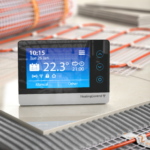In today’s construction landscape, the demand for lighter, quicker, and more efficient flooring systems is steadily growing. Nowhere is this more evident than in the increasing popularity of thin screeds. Whether you’re working on a renovation, commercial fit-out, or high-performance flooring solution, understanding how thin you can reasonably go without compromising durability or performance is vital.
But how thin is too thin? The answer, as always, depends on a few critical factors.
First, What Exactly Is a Thin Screed?
Screed is a levelling layer applied to the top of a subfloor to prepare a smooth, level surface for final floorcoverings. A “thin” flowing screed typically refers to a layer of flowing or anhydrite screed that is significantly shallower than traditional sand/cement screeds, which are usually laid at 50–100mm thickness. Thin screeds often fall within the 10–30mm range, although in some specialist applications they can be as slender as 5mm.
With a polymer-modified anhydrite composition, thin screeds are especially designed to offer value through their strength, adhesion and flow properties – all essential when working at low depth.
Why Go Thin?
The benefits of using a thin screed are compelling:
- Reduced weight – particularly essential in delicate refurbishment projects or upper floors
- Faster drying times – minimising project delays
- Lower material use – saving on both cost and environmental impact
- Design flexibility – particularly where build-up height is limited
Key factors when using thinner screeds include substrate preparation, load considerations, and installation precision.
Minimum Thickness Guidelines
The typical range for flowing screeds is anywhere from 8mm to 40mm in thickness. The minimum recommended thickness of screed depends on factors such as the type of installation methods.
For bonded screeds, installed directly onto substrate, minimum thickness is often around 10mm, but some particularly formulated thin screeds can go as low as 5–6mm.
Thin creeds are not usually suited to unbonded installations, which are separated by a membrane, because the lack of a direct bond can increase the risk of movement and cracking.
Floating screeds, such as those over underfloor heating or insulation boards, generally have a minimum thickness of 30–35mm, sometimes more depending on the insulation compressibility and heating system type. Anything less than that may lead to insufficient load distribution.
Avoiding Going Too Thin
While using less material has a number of advantages, including saving cost and optimising thermal performance, shaving off too many millimetres can result in disastrous consequences. This includes cracking, delamination, load failure and incompatibility with finishes. It can also void particular manufacturer warranties.
To take full advantage of the thin and self-levelling properties of anhydrite screed, follow manufacturer’s guidelines carefully and ensure not to void manufacturer warranties. Always choose the right product for the job, considering the particular factors in your project. Finding professional screed installers with the expertise to support your flooring project can be essential to getting the right products installed in the right way, achieving a thin flowing screed layer that can maximise flooring potential.





